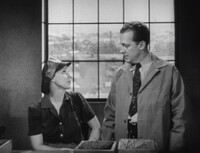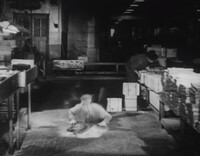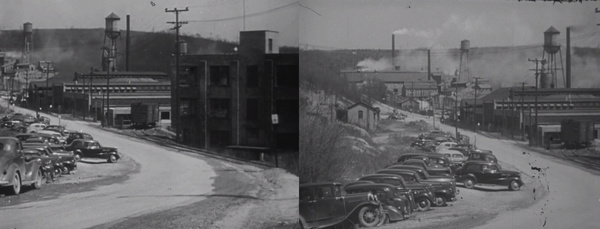Problems in Supervision
Many films in the series centered on newly-appointed managers talking through their responsibilities with more experienced managers. Like this scene from A New Supervisor Takes a Look at His Job.
David Isaac Pincus led a long and successful career producing a plethora of moving image materials. Pincus, based in New York, branched off into his own at Caravel Films, Inc. in 1921 after six years creating films at Universal Studios.34 Notably specializing in television advertisements but also producing a variety of other film projects including short films, educational productions, and government-backed works, Caravel Films, Inc. enjoyed rising success alongside the growth of the television market.35 The arrival of World War II brought with it a boom for the educational film industry as government agencies, freshly supplied with wartime funds, required the production of a multitude of new films. To coordinate the production of all these training films, a new branch within the Office of Education was created. The Office of Education’s Division of Visual Aids for War Training tallied 457 training films made between 1941 and 1945.36 For Caravel Films, this took the form of 34 government-backed films including much of the Office of Education’s Problems in Supervision series.
Aided by the demand for short films from the federal government and private business, Caravel Films, Inc. and its founder, David Isaac Pincus, would prosper in the following decades. In 1954, Pincus helped found the Film Producers Association of New York to aid in the sharing of information and resources between film producers in New York. Needing a larger space due to high demand, Caravel Films, Inc. opened a state-of-the-art one million dollar production space on Wednesday, October 23, 1957. Located at 60th Street and West End Avenue, the new four-story production center held three different sound stages, six editing rooms, and complete costume and make-up suites.37 Just two years later Caravel Films, Inc. was sold to Buckeye Corporation, one film production company in a string of film company acquisitions for the farm and outdoor equipment manufacturer.38 Pincus would land on his feet in Phoenix, co-founding Television City Arizona, Inc. Throughout his 40 year career in film production, David Pincus would help to make over 5,000 television commercials, in addition to a multitude of short and feature-length films.39

The federal government turned to the Office of Education for training materials on a variety of topics by World War II.
Armed with a massive war chest the Office of Education, along with its new Division of Visual Aids for War Training dedicated to education films, created the Problems in Supervision series during the war. Consisting of 22 films on a variety of industrial workplace and management topics, the series would likely have been shown to new workers, freshly promoted employees, and as refreshers for experienced managers and supervisors.40 These films, with a length usually between 10 and 20 minutes, came into Indiana University’s Moving Image Archive through transfer from IU Library’s Instructional Support Services. The Bureau of Audio-Visual Aids, renamed in 1945 to the Indiana University Audio-Visual Center, was one of the largest lending services for films in the United States during World War II.41 Public education films like this series were screened heavily, as is evidentin degradation present in some of the films in IU’s collections, leading to many copies being unusable and discarded.42 Film techniques centered around close up shots of individual workers and intimate scenes between workers and their families at home. Heavy usage of male narration would proliferate throughout most films. Likely as a cost savings or production time measure, some footage was reused between films. For instance, the same shot of the outside of a factory is used in Planning and Laying Out Work and Working with Other Supervisors, as shown in the photo below.43 Regardless, production quality was high and the variety of topics allowed for a film to fit almost any U.S. business.
The series reflected the dramatic wartime employment changes happening on the homefront. While holding messages for most laborers in factory settings, these films targeted new and existing managers and supervisors having to adjust old ways of doing business in the light of new labor realities. The series centered on white males in charge, with women portrayed commonly as completely unsorted in factory environments.44 Some films neglected to add women in the workplace at all, with very few if any including minorities.45 The goal for this series was to maintain and increase productivity for the war effort by laying out more workable management practices. It’s impossible to measure the effectiveness of these films in the actual workplace, but due to distribution centers, like IU, these films were regularly available during the war.

Problems in Supervision addressed new workplace dynamics for male supervisors, like this shot depicting a male boss discussing the work performance of a female employee.

Workplace safety, as demonstrated in this scene of a man tripping, was a common topic in these films.



